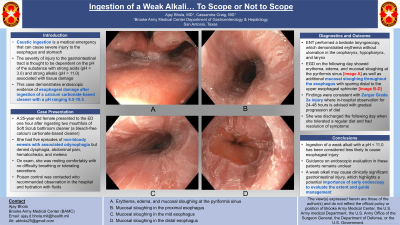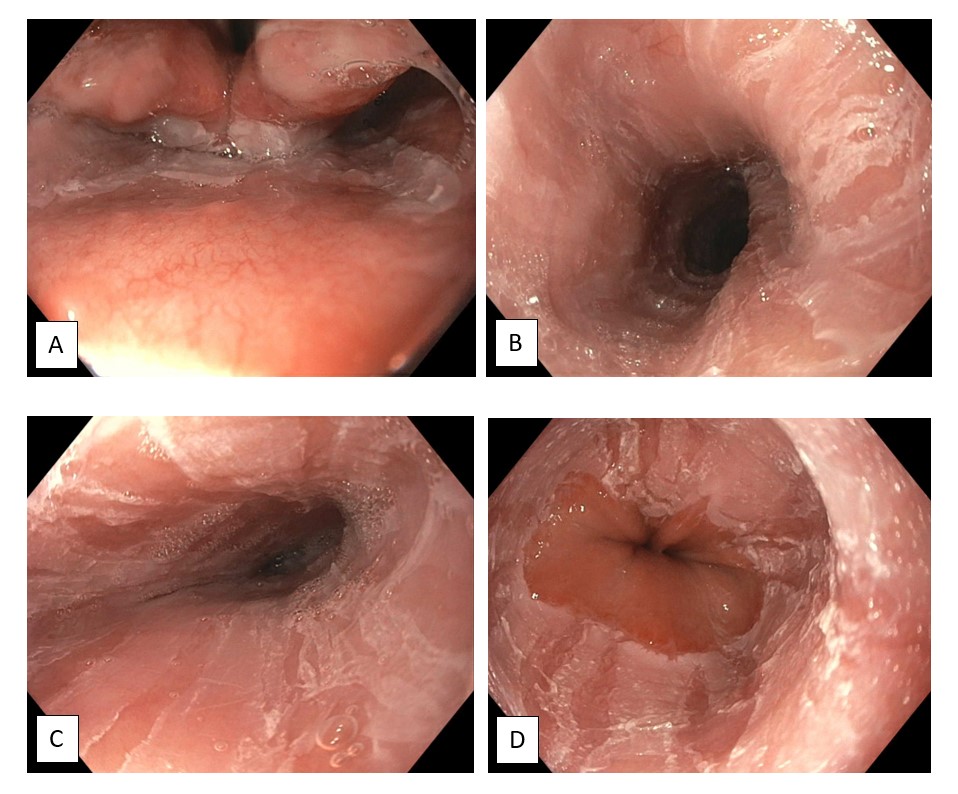Sunday Poster Session
Category: Esophagus
P0586 - Ingestion of a Weak Alkali: To Scope or Not to Scope
Sunday, October 27, 2024
3:30 PM - 7:00 PM ET
Location: Exhibit Hall E

Has Audio

Ajay D. Bhola, MD
Brooke Army Medical Center
Fort Sam Houston, TX
Presenting Author(s)
Ajay D. Bhola, MD, Cassandra L. Craig, MD
Brooke Army Medical Center, Fort Sam Houston, TX
Introduction: Caustic ingestion is a medical emergency that can cause severe injury to the esophagus and stomach. The severity of injury to the gastrointestinal tract is thought to be dependent on the pH of the substance with strong acids (pH < 2.0) and strong alkalis (pH > 12.0) associated with tissue damage. This case demonstrates endoscopic evidence of esophageal damage after ingestion of a calcium carbonate-based cleaner with a pH ranging 9.5-10.5.
Case Description/Methods: A 25-year-old female presented to the emergency department one hour after ingesting Soft Scrub bathroom cleaner. The patient reported that she ingested two mouthfuls of the bleach-free calcium carbonate-based cleaner. In the emergency room, the patient had five episodes of non-bloody emesis with associated odynophagia and denied dysphagia, abdominal pain, hematochezia, and melena. She was resting comfortably on arrival with no difficulty breathing or tolerating secretions.
The emergency room physicians contacted poison control, who recommended hydrating the patient with fluids as well as continued observation in the hospital. ENT was consulted, who performed a bedside laryngoscopy, which was significant for erythema without ulcers in the oropharynx, hypopharynx, and larynx. They subsequently recommended consultation to GI for an EGD to further evaluate.
An EGD was performed on the following day, which was significant for mucosal sloughing throughout the esophagus with some sparing just distal to the upper esophageal sphincter consistent with Zargar Grade 2a injury, as well as mild antral gastropathy. An upper airway exam was notable for erythema, edema, and mucosal sloughing at the pyriformis sinus, consistent with the exam by ENT. The patient was started on a clear liquid diet with a recommendation to advance as tolerated and monitor for 24-48 hours. She was discharged on the following day after she tolerated a regular diet and had resolution of symptoms.
Discussion: Our patient presented after ingesting a calcium carbonate-based cleaner with a pH ranging 9.5-10.5, which caused mucosal sloughing of the esophagus based on endoscopic evaluation. Typically, ingested substances with a pH < 12.0 have been considered less likely to cause esophageal injury and therefore guidance on endoscopic evaluation remains unclear. However, this case demonstrates that a weaker alkali may also cause clinically significant gastrointestinal injury and highlights the potential importance of early endoscopy to evaluate the extent and guide management.

Disclosures:
Ajay D. Bhola, MD, Cassandra L. Craig, MD. P0586 - Ingestion of a Weak Alkali: To Scope or Not to Scope, ACG 2024 Annual Scientific Meeting Abstracts. Philadelphia, PA: American College of Gastroenterology.
Brooke Army Medical Center, Fort Sam Houston, TX
Introduction: Caustic ingestion is a medical emergency that can cause severe injury to the esophagus and stomach. The severity of injury to the gastrointestinal tract is thought to be dependent on the pH of the substance with strong acids (pH < 2.0) and strong alkalis (pH > 12.0) associated with tissue damage. This case demonstrates endoscopic evidence of esophageal damage after ingestion of a calcium carbonate-based cleaner with a pH ranging 9.5-10.5.
Case Description/Methods: A 25-year-old female presented to the emergency department one hour after ingesting Soft Scrub bathroom cleaner. The patient reported that she ingested two mouthfuls of the bleach-free calcium carbonate-based cleaner. In the emergency room, the patient had five episodes of non-bloody emesis with associated odynophagia and denied dysphagia, abdominal pain, hematochezia, and melena. She was resting comfortably on arrival with no difficulty breathing or tolerating secretions.
The emergency room physicians contacted poison control, who recommended hydrating the patient with fluids as well as continued observation in the hospital. ENT was consulted, who performed a bedside laryngoscopy, which was significant for erythema without ulcers in the oropharynx, hypopharynx, and larynx. They subsequently recommended consultation to GI for an EGD to further evaluate.
An EGD was performed on the following day, which was significant for mucosal sloughing throughout the esophagus with some sparing just distal to the upper esophageal sphincter consistent with Zargar Grade 2a injury, as well as mild antral gastropathy. An upper airway exam was notable for erythema, edema, and mucosal sloughing at the pyriformis sinus, consistent with the exam by ENT. The patient was started on a clear liquid diet with a recommendation to advance as tolerated and monitor for 24-48 hours. She was discharged on the following day after she tolerated a regular diet and had resolution of symptoms.
Discussion: Our patient presented after ingesting a calcium carbonate-based cleaner with a pH ranging 9.5-10.5, which caused mucosal sloughing of the esophagus based on endoscopic evaluation. Typically, ingested substances with a pH < 12.0 have been considered less likely to cause esophageal injury and therefore guidance on endoscopic evaluation remains unclear. However, this case demonstrates that a weaker alkali may also cause clinically significant gastrointestinal injury and highlights the potential importance of early endoscopy to evaluate the extent and guide management.

Figure: A. Erythema, edema, and mucosal sloughing at the pyriformis sinus
B. Mucosal sloughing in the proximal esophagus
C. Mucosal sloughing in the mid esophagus
D. Mucosal sloughing in the distal esophagus
B. Mucosal sloughing in the proximal esophagus
C. Mucosal sloughing in the mid esophagus
D. Mucosal sloughing in the distal esophagus
Disclosures:
Ajay Bhola indicated no relevant financial relationships.
Cassandra Craig indicated no relevant financial relationships.
Ajay D. Bhola, MD, Cassandra L. Craig, MD. P0586 - Ingestion of a Weak Alkali: To Scope or Not to Scope, ACG 2024 Annual Scientific Meeting Abstracts. Philadelphia, PA: American College of Gastroenterology.

